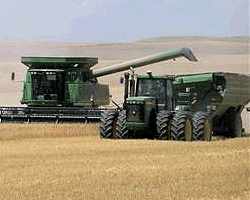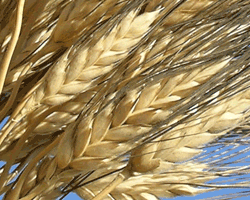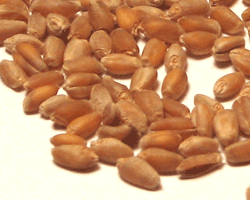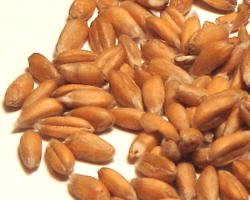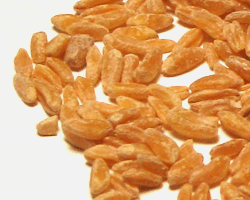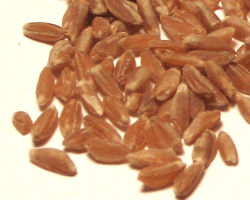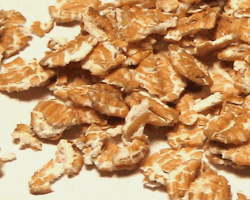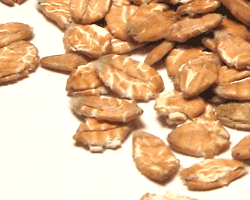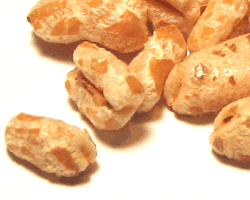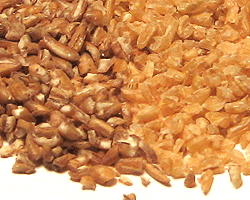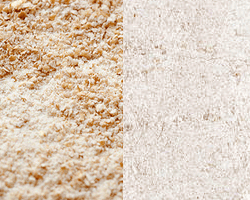Different varieties of wheat look fairly similar – but may offer different nutrients, or be digested a bit differently. While people with celiac disease should avoid all varieties of wheat, some research indicates that less-common varieties of wheat such as Einkorn, Emmer, Spelt and Khorosan wheat may be digested differently and can be consumed by some people with different types of wheat sensitivities, especially when eaten in fermented forms (such as sourdoughs).
|
Wheat Field during Harvest An organic wheat harvest in Wyoming, near the Nebraska border. Each combine is 23 feet tall and cuts a 36 foot side path, and each grain bin olds 350 bushels. |
|
|
Wheat Ready for Harvest This is what wheat looks like before the individual kernels are separated from the spikes. |
|
|
Red Wheat Berries Individual wheat kernels are usually referred to as “wheat berries” when they’re sold in stores. You can cook these whole kernels, or berries, just as you’d cook rice – to enjoy as a side dish. Red Wheat is the most commonly-grown wheat in the U.S. An albino variety of wheat, called White Wheat, has a lighter color and milder taste but is equally nutritious. |
|
|
Spelt Spelt is perhaps the best known of the “ancient” wheats. Some eight centuries ago, when spelt had already been cultivated for several millennia, Hildegard von Bingen wrote of spelt, “The spelt is the best of grains. It is rich and nourishing and milder than other grain. It produces a strong body and healthy blood to those who eat it and makes the spirit of man light and cheerful.” Today, once again, spelt breads and pastas are fairly widely available. |
|
|
Khorosan Wheat Khorosan wheat, often sold under the brand name Kamut®, is considered a type of durum wheat. As part of the brand identity, Kamut® khorosan is always organic, and is higher in zinc, magnesium and especially selenium, when compared to modern wheat. Kamut® khorosan is especially popular in Italy, a country responsible for about half of world-wide production. Click here for more. |
|
|
Emmer or Farro Emmer, also known as Farro, is one of the oldest forms of wheat we know. Pliny the Elder, natural historian of the Roman Empire, wrote about emmer as already ancient in his time; he described how it was formerly called adoreum (or “glory”) and played a major role in religious sacrifices. |
|
|
Wheat Flakes We’re used to seeing oats in flaked (rolled) form. You may be surprised to know that wheat flakes are also widely available (we bought these at our local health food store) and make a fun addition to baked goods or a tasty breakfast cereal. |
|
|
Spelt Flakes Ditto everything above, but this time these are spelt flakes. |
|
|
Kamut® Puffs Any kind of wheat can be puffed. These puffs just happen to be made from Kamut®. Unlike corn, amaranth, and sorghum, all of which can be puffed (think popped!) in your kitchen, it takes industrial machinery to get wheat to pop open like this. |
|
|
Bulgur Wheat Bulgur is not a variety of wheat like those above – it’s a traditional way of processing wheat. To make bulgur, the wheat kernels are cooked, then dried, then broken up into smaller pieces. Because bulgur is largely pre-cooked, you can “finish it off” in your kitchen in about 15-20 minutes. Two kinds of bulgur are pictured here: red wheat bulgur on the left and white wheat bulgur on the right. |
|
|
Whole Wheat Flours Yes, these are BOTH whole wheat flours. On the left you see traditional whole wheat flour, made from red wheat, and on the right, it’s white whole wheat flour, made from white wheat. |
Other varieties of wheat not pictured above:
In truth there are many, many varieties of wheat not pictured above. But these two seemed especially important to mention.
Durum Wheat [Triticum turgidum L. group Durum Desf.]
Durum is a hard wheat, high in protein, that’s commonly used to make pasta and couscous. Most durum wheat grown today is amber durum, which has a delightful golden color. Durum wheat grows well without irrigation, making it well suited to dry climates.
Einkorn [Triticum monococcum L]
Generally thought to be the most ancient of wheat varieties available today, einkorn is still grown in Austria, southern France (where it’s called petit épeautre), Germany, and some eastern European countries. Studies show that compared to modern wheat it’s higher in protein, phosphorus, potassium, and beta-carotene, among other nutrients. Click here for more.
Promoting Diversity in Wheat. More and more people are promoting the importance of diversity in grains and other foods, and there is a growing movement to preserve and promote ancient landrace varieties of wheat. Click here or here to learn more about this movement.
Photo Credits: top photo courtesy Bay State Milling; second photo from Kamut International. All other photos from the Whole Grains Council.

